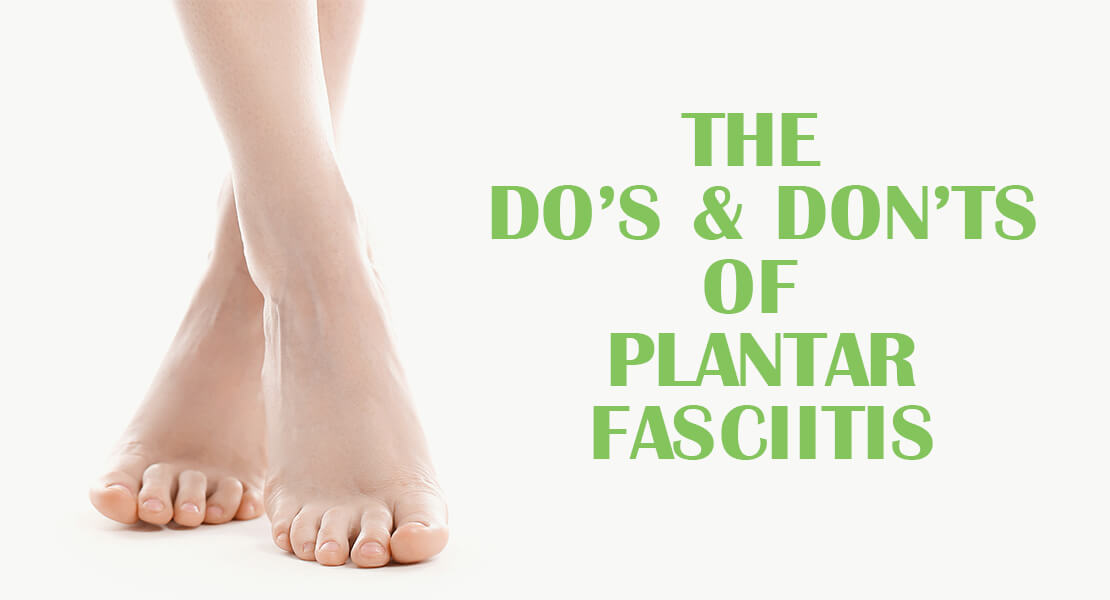Every runner or person who needs to be on the move knows that plantar fasciitis is one of the worst injuries and pains they can experience. People with plantar fasciitis have been stopped for months, or even years, due to this common injury that affects the foot from the sole through the heel and up the back. When you have plantar fasciitis, there are numerous things you should and should not do. There are also conservative treatments for pain relief. Here is a rundown on what to avoid and what can help to alleviate the effects of plantar fasciitis, and how to prevent it:

The Do’s and Don'ts of Plantar Fasciitis
Plantar fasciitis (PLAN-tur fas-e-I-tis) is one of the most common causes of heel pain. It involves pain and inflammation of the thick band of tissue on the bottom of your foot, called the plantar fascia. It connects the heel bone to the toes and creates the arch of the foot. When the plantar fascia becomes inflamed, it is called plantar fasciitis.Plantar fasciitis can cause stabbing pain that usually occurs as you step out of bed in the morning or when you stand up after sitting for a long period of time. Once your foot warms up, the pain of plantar fasciitis normally decreases, but it may return after long periods of standing or after getting up from a seated position.Plantar fasciitis is particularly common in runners, but people who are overweight and those who wear shoes with inadequate support are also at risk of plantar fasciitis.
It is highly recommended that you seek the opinion of a medical professional for the diagnosis and treatment of plantar fasciitis, but here are a few do’s and don’ts that you can do on your own to help prevent getting plantar fasciitis.
The Do’s of Plantar Fasciitis
- Rest– One of the treatment options that you can do at home is that your body must rest to heal. If you start feeling pain in your feet, take some time off of your routine. That may mean that you give up your usual exercise routine for a while, but it is the best thing to do. You can find alternative ways to exercise which are considered more “non-weight bearing” activities. Swimming and biking are great alternatives to running or aerobics. Consider any activity that keeps the weight off of your feet. Remember, running usually means 2-3 times your body weight transferring through your feet with every stride!
- Stretching-Stretching and strengthening the muscles of the ankle and foot will not only help in your recovery but will also help to prevent the pain from recurring. You can also use night splints as it alleviates the pain while it stretches the plantar fascia. Wearing a night splint while sleeping can help keep your foot stretched while you sleep so the pain is diminished in the morning. You should also keep a towel near your bed so you can stretch your feet in the morning before you stand up. Standing up without stretching out your feet can cause real damage and should be avoided at all times!
- Ice and elevation (RICE Method) – If you continue the movement that places pressure on your foot, even walking, it’s important to ice frequently and elevates to reduce swelling. Use the RICE method, one of the home remedies, as it stands for Rest, Ice, Compression, and Elevation. At the end of the day, wrap the arch of your feet with an ice pack and a compression bandage or sock. Elevate your foot and rest your foot for 20-30 minutes. Ask your doctor for any medical advice regarding your foot condition.
The Don’ts of Plantar Fasciitis
- Don’t push through the pain. Often a couple of weeks of reduced activity and following the steps above will help tremendously. Pushing through the pain can lead to increased tearing of the plantar fascia which can lead to rupturing of the plantar fascia. Pain is the body’s way of letting us know to take it easy, so it’s best to listen!
- Don’t go barefoot. Going barefoot while dealing with plantar fasciitis is a definite no-no. You can get a pair of slippers or sandals with good support for use around the house. You should also wear a good pair of shoes with arch support during the day. Just because you do not feel the pain during the daytime doesn’t mean you are not causing damage. Shoes that have a good arch and heel support should be worn at all times until weeks after the pain subsides. You should also wear supportive shoes if you have flat feet or high arches, which are conditions that can increase your risk of developing plantar fasciitis or make the condition worse. Also, you should consider replacing your athletic shoes after 250-300 miles of wear. This mileage can add up quickly so it is important to track your overall usage. Just because a pair of shoes doesn’t visually appear to be worn out, does not mean they have not gone past their recommended mileage. If you average 5 miles per day, 5 days per week, you are logging 25 miles per week on your running shoes. If you only wear your running shoes for running and nothing else, you will wear those shoes out in 10-12 weeks. Most people wear their running shoes for many other occasions other than running, which adds more miles to those shoes.
- Don’t assume that you’ll never get back to exercising again! Look for alternative exercises that don’t require you to push off your foot. For many people, this can be one of the largest obstacles to healing any foot-related issue. The main reason why inflammations in our feet are so difficult to heal is that it is so challenging to simply “get off our feet”. The main habit that can change for most people is the way you exercise. Continuing to run while trying to heal plantar fasciitis will make the healing process very difficult. This is not to say you will never run again! Plantar fasciitis is inflammation and absolutely can heal if allowed to. Consider biking, swimming, or weight training as alternatives until your condition has fully healed.
Habits That Can Worsen Plantar Fasciitis
Those who suffer from plantar fasciitis know all too well the excruciating heel pain that might keep them from doing their daily activities. This frequent orthopedic ailment often manifests itself most strongly when rising from a seated position or upon getting out of bed in the morning.
Because of the repetitive stress placed on the plantar fascia, this condition can develop, and certain activities can aggravate existing plantar fasciitis symptoms. Bad habits can cause tissue damage as well as chronic heel pain. Watch out for the following practices that could aggravate your plantar fasciitis:
Being Overweight
Diabetes, cardiovascular disease, and even plantar fasciitis are just a few of the many health problems that can be made worse by excess weight. High body mass index (BMI), a ratio of one's weight to one's height, is strongly correlated with the onset of foot issues like plantar fasciitis.
Because the plantar fascia is band of tissue than runs along the bottom of the foot, it takes a bigger hit when one is overweight than when one is at a healthy weight. When you're even a single pound over your optimal weight, you put an extra eight pounds of pressure on your knees, hips, and ankles. And the pressure can rise by a factor of four to six just by walking up a flight of steps.
Sitting or Standing For Long Periods of Time
The plantar fascia might become worn down if prolonged sitting or standing is a regular component of your employment or everyday activities. The sensation is amplified when one's feet are planted firmly on hard, artificial surfaces like asphalt or concrete.
If you stand for extended lengths of time, it's important to take breaks and sit down periodically, and if you sit for long periods of time, it's important to get up and move around every so often. If you have to stand for an extended period of time, vary your posture as much as possible. There are also unnatural positions that you must avoid.
Wearing the Wrong Type of Shoe
It may be more practical to wear flat shoes like flip-flops or even go barefoot, but doing so can lead to plantar fasciitis. Putting too much weight on your feet without adequate arch support or padding might cause strain on your plantar fascia.
Additionally, the issue can be made worse by wearing shoes that are overly tight or with a heel that is raised too far above the level of the toes. This shoe style restricts your foot's normal motion, which can strain ligaments and tendons like the plantar fascia. Wearing high heels for a long period of time can strain your lower leg and your feet. You must wear a shoe that has arch supports as well as a shock absorber.
Neglecting Your Stretches and Strengthening Exercises
Protect yourself from developing plantar fasciitis by stretching before you work out or do any other physical activity that puts stress on your feet. One of the greatest methods to avoid injuring your plantar fascia is to loosen it.
Furthermore, your plantar fascia can benefit from working on your leg muscles specifically the calf muscles, Achilles tendon, and the soles of your feet. Keeping your foot stable by strengthening these areas will help you avoid or delay the onset of plantar fasciitis.
What Are The Consequences of Leaving Plantar Fasciitis Untreated?
Did you know that simple and conservative therapies are effective in 90% of plantar fasciitis cases? But the longer this foot disease continues untreated, the longer the healing process and the more possible consequences can occur. If you ignore this foot problem, you may experience the following serious complications:
Plantar Tears
Tiny tears in the plantar fascia can develop as a result of chronic inflammation and strain on the tissue. Your pain levels will rise steadily, and if you don't do something about it, the tears in your plantar fascia might get worse and eventually cause them to burst and leave you unable to walk altogether.
Plantar Ruptures
If you have a foot problem and don't treat it but still do activities that are hard on your feet, you could end up tearing your plantar fascia. Jogging, shoes that don't fit properly, and standing for lengthy periods are just a few examples.
Plantar ruptures can cause a wide range of unpleasant side effects, including:
- Loud popping
- Severe agony
- Foot swelled and bruised
Additionally, weight bearing on the affected foot will be excruciatingly painful, and if you suspect a plantar rupture, you should see a podiatrist or healthcare provider immediately.
Development of Heel Spurs
Untreated plantar fasciitis almost always results in painful heel spurs. The body deploys a squadron of cells to the affected area, where they begin depositing calcium in an effort to repair the arch of the foot and prevent further damage.
It is possible for these deposits to accumulate and form sharp protrusions that dig into the fatty pad of the heel, causing excruciating pain with every stride.
In short, not taking action can make plantar fasciitis worse. Seeking treatment for plantar fasciitis is crucial because untreated plantar fasciitis pain can worsen over time, making daily activities unbearable. A comprehensive treatment plan, including using a night splint, lifestyle changes, steroid injections, and—not only well-fitting pairs of shoes but—supportive shoes, can significantly reduce foot pain, hasten the recovery process and promote healing.
8 Brands for Plantar Fasciitis
If you have plantar fasciitis, these brands have amazing products to help you prevent it and to stop any possible worsening. Get any product from these brands at Lucky Feet Shoes and start building a new beginning for your feet!

Sovella
Sovella "healing" sandals are widely considered to be the most comfortable of their kind. Men's and women's Sovella Original shoes are designed to reduce fatigue and pain in the feet through biomechanical engineering.

Dansko
Dansko has been working since 1990 to establish itself as a reliable brand of comfort footwear for anyone in need of relief from foot pain. The Pennsylvania-based company was co-founded by husband-and-wife duo Peter Kjellerup and Mandy Cabo, most recognized for their functional array of comfort clogs, formal shoes, and casual shoes.

ECCO
ECCO is known for its high-quality, beautifully designed, and affordable footwear for both men and women. Since its inception in 1963, the Danish shoemaker has pushed the envelope by rethinking minimalist design, elevating the level of comfort, and improving golfers' performance.

HOKA
The designers of HOKA shoes set out to simplify jogging. HOKA takes a novel approach to both the aesthetics and functionality of their footwear. Wearing a pair of HOKAs for the first time is enough to convince you of the brand's superiority.

Olukai
A variety of water-friendly sandals, sneakers, and boots from OluKai draw inspiration from the islands of Hawaii. Live the laid-back ocean lifestyle in OluKai's stylish, long-lasting, and incredibly comfortable footwear and apparel. Aloha to genuine leather and painstaking attention to detail.

New Balance
In addition to being aesthetically pleasing, the men's and women's New Balance footwear collection provides cushioning, arch support, and a smooth ride, making them ideal for everyday wear or training for a 5K. The New Balance brand has expanded to become a worldwide market leader in the sportswear industry.

Brooks
When it comes to "thinking on their feet," Brooks has been at it for more than a century. They say they eat, breathe, and stretch in preparation for their race. With any luck, the people in the areas they reach will be inspired to take up running as a team, thanks to Brooks' efforts.

Aetrex
Aetrex's goal since 1946 has been to design the world's healthiest shoes. There is a vast selection of men's and women's casual, dress, sports, sandal, and therapeutic shoes available in a number of widths and sizes.
Where to Buy Shoes for Plantar Fasciitis
Come into any one of our stores located in Redlands, Anaheim Hills, Rancho Cucamonga, Riverside, San Dimas, Long Beach, Temecula, La Quinta, and Palm Desert, today and shop our comfortable shoes for standing all day! At Lucky Feet Shoes, we carry many comfortable shoes: sandals, heels, walking shoes, running shoes, casual sneakers, clogs, wedges, flats, booties, and boots. Come and visit us today! If you are looking for Comfortable Men’s and Women’s Shoes in Orange County, the Inland Empire, Los Angeles County, Temecula, or Riverside; we have nine comfort shoe stores to serve you!

Jerick Sobie
Since 2005, I have been a dedicated small business owner specializing in footwear retail. With over 20 years of experience, my business partner and I have helped customers find the perfect shoes that combine style, comfort, and quality. Our expertise extends beyond local sourcing—we have traveled internationally to discover high-quality footwear that meets our customers’ needs. In addition to running my business, I have participated in numerous health fairs and educational seminars, sharing my knowledge on proper footwear and foot health. Committed to providing exceptional service, We carefully curate our selections to ensure the best fit and support for every customer.






















